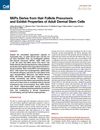Introduction to Hair-Follicle-Associated Pluripotent Stem Cells
January 2016
in “
Methods in molecular biology
”
hair-follicle-associated pluripotent stem cells HAP stem cells nestin-expressing cells neurons glial cells peripheral nerve repair spinal cord injuries hair follicle nerves 3D histoculture sensory nerve growth cardiac muscle cells regenerative medicine embryonic stem cells induced pluripotent stem cells autologous cells non-tumorigenicity nerve repair nerve growth heart muscle cells stem cell therapy
TLDR HAP stem cells can repair nerves, grow hair follicle nerves, and become heart muscle cells, making them useful for regenerative medicine.
The document discussed the discovery and potential of nestin-expressing hair-follicle-associated pluripotent (HAP) stem cells, which could form various cell types, including neurons and glial cells, and aid in the repair of peripheral nerve and spinal cord injuries. HAP stem cells were shown to grow and extend hair follicle nerves in 3D histoculture, suggesting their role in sensory nerve growth. Additionally, these cells could differentiate into cardiac muscle cells, offering advantages for regenerative medicine over embryonic and induced pluripotent stem cells due to their accessibility, autologous nature, non-tumorigenicity, and lack of ethical issues.
